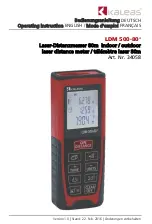
Atlas
LCR
User Guide
August 2015 – Rev 6
Page 10
Large Capacitors
Capacitors larger than about 1μF are treated differently,
instead of being tested with an AC signal, they are tested with
a DC signal. This is confirmed in the “Test frequency” screen.
Please be patient when testing large value capacitors, it may
take several seconds depending on the capacitance.
For capacitance values of greater than 1000μF, the Atlas LCR will use the
units of mF (milli-Farads). Don’t confuse milli-Farads with micro-Farads,
1mF=1000μF.
Capacitors (particularly electrolytics) can store enough charge that
may cause damage to the LCR.
An electrolytic capacitor can even develop it’s own stored charge that
may be sufficient to cause damage to the Atlas LCR even after it has
been temporarily discharged. This is a characteristic known as
“Soakage”.
It is vitally important that you ensure the capacitor is fully discharged
(ideally for several seconds) to minimise the possibility of damage to the
unit.
If you are unsure, measure the voltage across the capacitor using a
suitable volt meter before applying the capacitor to the Atlas LCR.
Generally, tantalum capacitors and electrolytic capacitors are
polarised. The Atlas LCR, however, uses a maximum of 1V to test the
capacitor and so polarity of the Atlas LCR test probes is (usually)
unimportant.





































